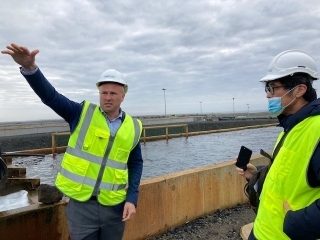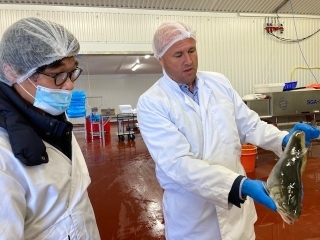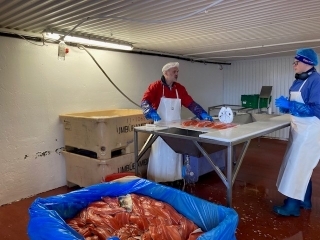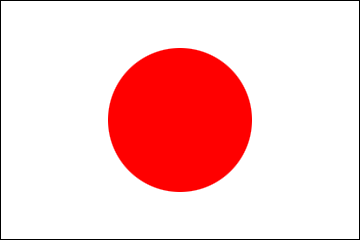From Ambassador (Visit to Matorka)
2021/9/6



Have you heard of a fish named “Arctic Char”?
In Japan, this fish is called “Hokkyoku-Iwana”. Iwana is a rather small fish inhabiting in streams. While being closely related to both salmon and trout, Arctic Char becomes fairly large when reaching adulthood. The meat is also pink just like salmon’s, and quite delicious either cooked or not (as in Sashimi).
The other day, I visited a company in Grindavík, about 40-minute drive away from Reykjavík, called Matorka, which cultivates, processes, and ships Arctic Char. Grindavík has long prospered as a port town.
There are various innovative companies with unique ideas that take advantage of the natural resources in Iceland and Matorka is one of them.
Arni-san, CEO of Matorka, kindly gave us a tour of his company.
Arni-san studied at Saitama University as a Japanese Government’s scholarship student and speaks fluent Japanese. He naturally introduced his company in Japanese. (The Icelandic pronunciation for Arni is /ˈaurtnɪ/ but he introduced himself as “A-ru-ni”, which is easier for me to pronounce.)
Although Arctic Char is a freshwater fish that inhabits low-salt water such as lakes and rivers in nature, some fishes including salmon, which belong to the same salmonid family, spend part of their lives in the sea.
The characteristics of Matorka’s fish farming method is that the Arctic Char is cultivated in a pool-like facility installed in land. The water they use is abundant groundwater filtered by lava stones and contains a small amount of salt that seeps from the ocean, consequently making the water not fit for drinking but perfect for fish farming. Fry hatched from eggs are raised in a low-salt facility elsewhere in the southern Iceland until they become about 150 grams and then transferred here.
Salmon farming with sea cages has been practiced in Norway, Chile, Iceland and so forth, but with the traditional method, it is difficult to monitor parasites and levels of antibiotic materials in the sea, which can cause pollution of nearby seawater. At Matorka, they don’t need to worry about such risks, since they are using filtered groundwater.
I ate slices of Arctic Char Sashimi which were kindly offered to us by Arni-san and they were soft and very savory.
Unfortunately, the fish farmed by Matorka hasn‘t been exported to Japan, yet.
In Japan, Arctic Char is not well-known, and hence the market value hasn’t been established there yet. Furthermore, since its freshness is a selling point, logistics play a key role. Currently, it is shipped by air to North America and by regular liners to the Port of Amsterdam to Europe. To be shipped to Japan, I think that it is necessary to secure high-end buyers.
With abundant fishing grounds in its coastal waters and the fishery sector as its core industry, Iceland has been able to develop its economy. However, fish resources fluctuate greatly, and it is not rare to hear the complaint that fish stocks that used to be caught in abundance are now in short supply. There is a limit to how much one can rely on natural fishery resources.
There seems to be more room for expansion for the fish farming enterprise at Matorka as it has no such limitation.
In Japan, this fish is called “Hokkyoku-Iwana”. Iwana is a rather small fish inhabiting in streams. While being closely related to both salmon and trout, Arctic Char becomes fairly large when reaching adulthood. The meat is also pink just like salmon’s, and quite delicious either cooked or not (as in Sashimi).
The other day, I visited a company in Grindavík, about 40-minute drive away from Reykjavík, called Matorka, which cultivates, processes, and ships Arctic Char. Grindavík has long prospered as a port town.
There are various innovative companies with unique ideas that take advantage of the natural resources in Iceland and Matorka is one of them.
Arni-san, CEO of Matorka, kindly gave us a tour of his company.
Arni-san studied at Saitama University as a Japanese Government’s scholarship student and speaks fluent Japanese. He naturally introduced his company in Japanese. (The Icelandic pronunciation for Arni is /ˈaurtnɪ/ but he introduced himself as “A-ru-ni”, which is easier for me to pronounce.)
Although Arctic Char is a freshwater fish that inhabits low-salt water such as lakes and rivers in nature, some fishes including salmon, which belong to the same salmonid family, spend part of their lives in the sea.
The characteristics of Matorka’s fish farming method is that the Arctic Char is cultivated in a pool-like facility installed in land. The water they use is abundant groundwater filtered by lava stones and contains a small amount of salt that seeps from the ocean, consequently making the water not fit for drinking but perfect for fish farming. Fry hatched from eggs are raised in a low-salt facility elsewhere in the southern Iceland until they become about 150 grams and then transferred here.
Salmon farming with sea cages has been practiced in Norway, Chile, Iceland and so forth, but with the traditional method, it is difficult to monitor parasites and levels of antibiotic materials in the sea, which can cause pollution of nearby seawater. At Matorka, they don’t need to worry about such risks, since they are using filtered groundwater.
I ate slices of Arctic Char Sashimi which were kindly offered to us by Arni-san and they were soft and very savory.
Unfortunately, the fish farmed by Matorka hasn‘t been exported to Japan, yet.
In Japan, Arctic Char is not well-known, and hence the market value hasn’t been established there yet. Furthermore, since its freshness is a selling point, logistics play a key role. Currently, it is shipped by air to North America and by regular liners to the Port of Amsterdam to Europe. To be shipped to Japan, I think that it is necessary to secure high-end buyers.
With abundant fishing grounds in its coastal waters and the fishery sector as its core industry, Iceland has been able to develop its economy. However, fish resources fluctuate greatly, and it is not rare to hear the complaint that fish stocks that used to be caught in abundance are now in short supply. There is a limit to how much one can rely on natural fishery resources.
There seems to be more room for expansion for the fish farming enterprise at Matorka as it has no such limitation.
